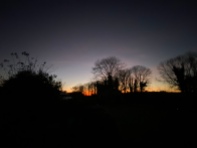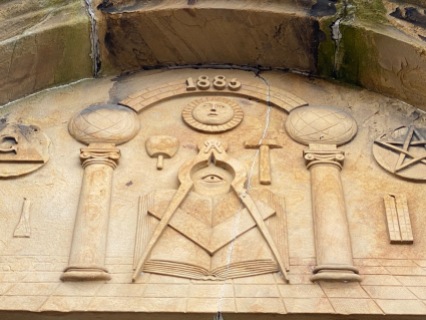
I was struggling with the height of the walls – 10 metres. I am distinctly medium in height; my two sons tower over me, at six foot, three inches each. But ten metres is a long way into anybody’s domestic sky; and yet that’s how tall the central stone tower of the Broch of Gurness was.

The small cheeseboard (above) bought in Kirkwall, the capital, has served us well as geography prop. Locate the island of Rousay and, from its south coast, drop down to the shark-shaped headland on the West Mainland below. That’s where we are, at the Broch of Gurness, with Rousay opposite, so close you feel you could swim to it – but those waters are treacherous…

I hope someone else is asking, ‘What’s a Broch?’ It’s a well-known word north of the border, but I had to ask the Historic Scotland guide at the tiny visitor centre; and felt diminished by his incredulous stare. He wasn’t being unfriendly; he was genuinely surprised at my ignorance – but only momentarily…

… He ceased grinding corn on the rotary quern- just long enough to educate me – and then resumed his skilful use of the two stones; a steady stream of flour, below, being the result. Inviting me to have a go by way of penance, he explained that a broch (pronounced ‘brock’) was a fortified tower at the centre of an ancient settlement. In this case the settlement was a large one, and, 2000 years ago, would have been one of the most important places on Orkney.
The sea is everywhere on Orkney. Indeed, after a few days of meeting it beyond each bend in the road, or over every gentle hill, you come to realise that Orkney is the sea, and that you are in a kind of paradise where the gentle curls and fronds of the welcoming land live, in gentle harmony, with the mother force of the blue-green waters. We gave you this, the waters seem to say. Look after it and that which gave it life and it will become home in your heart.

The mysterious Iron Age peoples who lived here, two thousand years ago, felt that way. The sea was their highway, and probably a big part of their religion, too. Along with the fertile land, it fed them.

Ten metres. It’s a long way up for a drystone wall… though the full height of the cental broch tower is long eroded. Newly educated at the grinding wheel, I worked hard to recall what the guide had said: You build that big because you are important. The tower is domestic – being the ‘royal’ dwelling, but it’s also defensive; you can see for miles from a height like that, and Orkney has hills but no mountains. In addition, you can watch and manage those near to you – surveying the farmed land around. It was a really important place, concluded the guide, letting me leave my grinding duties and enter the historic site.

There are over 500 brochs in northern and western Scotland, but those with sizeable villages like Gurness are peculiar to Orkney and northern Caithness. The history of archeology is full of fortunate accidents that lead to discovery. The coastal storm that revealed Scara Brae being a very good example. The story of the finding of the Broch of Gurness is one of the best.

There had been a large mound (locally ‘knowe’ at Gurness, close to the shore, for as long as anyone could remember. One day in 1929, an Orkney Scholar, Robert Rendall, was sketching on the top of the mound when one of the legs of his stool slid into the ground. He dug to examine why the ground had given way and ended up uncovering the top of the staircase on the west side of the broch tower. There had been widespread interest in excavating Orkney’s ancient history and a series of donations enabled formal excavations, which began in 1930. It was soon taken over by the Ministry of Public Buildings and Works, under whose aegis it continued until the onset of WW2 in 1939.
A similar mound at Midhowe, on the neighbouring island of, Rousay, was excavated at the same time, and skilled workmen were shared between the two sites. For its time, the work was very skilled and disciplined. The result was a great achievement for the people of Orkney, who now had living proof of the ancientness of their landscape.
The work continued after the war and, in the 1950s, consolidation of the work took place. Loose and broken stones were secured in place and all walls were made safe. A set of concrete cliff were constructed to offer some protection from the unpredictable seas.
The picture below, taken from the site’s visitor board, shows the extent of the excavation, as it is today. On the left hand side you can see how close it is (and was) to the sea. The picture also shows the dominance of the central broch tower, with its twin, hollow walls and vast dimensions.

By about 100 AD, the broch and its village were abandoned. Successive failures in the structure reduced its size, and the remains were re-used by generations of later settlers, up to Pictish times, around 700 AD. The Vikings never lived here, but, in the 9th century, they honoured the site by burying a noblewoman, along with her grave goods.

Further information from Historic Scotland.
©Stephen Tanham




























Reblogged this on Sue Vincent's Daily Echo.
LikeLiked by 2 people
Thank you, Sue x
LikeLiked by 1 person
Wonderful post. You understand Orkney well when you spoke about the sea, it is in our veins when we are born. I miss it so much. x
LikeLiked by 1 person
I can understand why, Adele. I felt the ‘connectedness’ very strongly. Mind you after that Sun-struck equinox, how could we not! x
LikeLiked by 1 person
How often do you get to go ‘home’?
LikeLiked by 1 person
I haven’t been home for 23 years, but keep in touch with Rousay folk over the internet. I’ve been away too long Steve.
LikeLiked by 1 person
Yes. Perhaps this will prompt a visit?
LikeLike
Reblogged this on Not Tomatoes.
LikeLiked by 1 person
Thank you, Alethea 😊
LikeLike